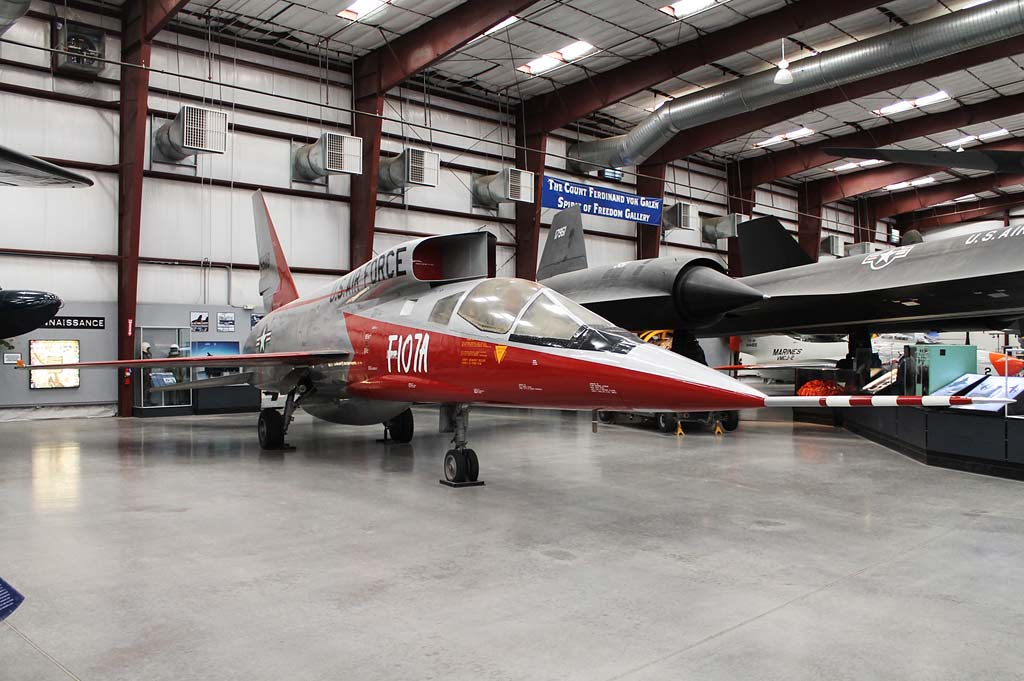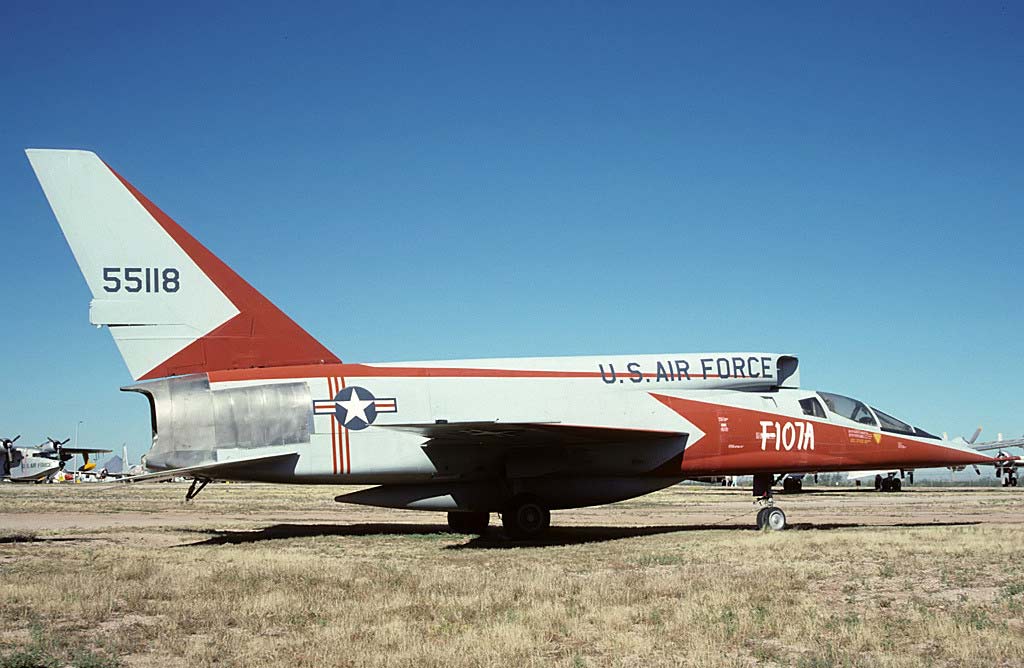The North American YF-107, also known as the Ultra Sabre, was a Mach 2-capable, nuclear delivery, research/fighter-bomber aircraft, featuring a unique dorsal air intake and advanced flight systems.
In Brief
The North American YF-107, developed from the F-100 Super Sabre, was a prototype jet fighter-bomber designed for the U.S. Air Force. It featured a distinctive dorsal air intake and an extended nose for radar. Powered by a Pratt & Whitney J57-P-9 turbojet with 24,000 lb of thrust, the YF-107 could reach speeds of Mach 2 and had a service ceiling of 53,199 ft. With a length of 61.8 ft, a wingspan of 36.6 ft, and a height of 19.3 ft, the aircraft was equipped with advanced flight control systems. It could carry up to 10,000 lb of external stores, including nuclear weapons, and was armed with four 20mm M-39E cannons. Despite its capabilities, the YF-107 did not enter production, losing out to the Republic F-105 Thunderchief.
The North American YF-107 Ultra Sabre was a remarkable yet ultimately unrealized advancement in jet fighter-bomber technology during the Cold War era. Developed as a potential successor to the F-100 Super Sabre, it was designed to meet the U.S. Air Force’s requirements for a supersonic tactical fighter capable of delivering nuclear ordnance.

History of Development
The development of the North American YF-107 began in the early 1950s, a period marked by rapid advancements in aviation technology and the intensifying Cold War. With the emergence of nuclear weapons as a key element in military strategy, the U.S. Air Force sought a new generation of fighter-bombers capable of delivering these weapons at high speeds and altitudes.
North American Aviation, the company behind the successful F-100 Super Sabre, was contracted to develop a new aircraft to meet these requirements. Initially designated the F-100B, the project was later renamed the F-107A to reflect significant design changes from the Super Sabre. The Air Force authorized the production of 33 aircraft on June 11, 1954, which was later reduced to three prototypes.
The first YF-107 prototype made its maiden flight on September 10, 1956. Pilots praised its performance, particularly its ability to achieve Mach 2.0 and its advanced flight controls. However, the aircraft faced competition from the Republic F-105 Thunderchief, which was also designed for the same mission. In a surprising decision in March 1957, the Air Force selected the F-105 over the YF-107 for production.
The three completed YF-107 prototypes were used for various research and development tests, contributing valuable data to high-speed, high-altitude flight research. Two of the prototypes were transferred to the National Advisory Committee for Aeronautics (NACA), later NASA, for further testing. The first and third prototypes are preserved as museum pieces, while the second prototype was scrapped.
Design
The North American YF-107 was a highly modified version of the F-100 Super Sabre, retaining its wings, rear fuselage, and tail section. The aircraft featured several innovative design elements that set it apart from its predecessor and contemporaries.
One of the most distinctive features of the YF-107 was its dorsal air intake, located above and behind the cockpit. This unusual configuration was chosen due to space constraints in the existing F-100 layout and was necessary to accommodate the aircraft’s powerful Pratt & Whitney YJ75-P-9 turbojet engine. The engine, with a thrust of 24,504 pounds, was equipped with an automated flight control system and a variable area inlet duct to control air intake at high speeds.
The YF-107 had a longer fuselage than the Super Sabre, measuring 61.8 feet in length, with a wingspan of 36.6 feet and a height of 19.3 feet. The aircraft’s all-moving vertical fin and automated control systems enhanced its maneuverability and stability, particularly at supersonic speeds. Instead of traditional ailerons, the YF-107 used spoilers atop the wings, allowing for efficient roll control.
The aircraft’s armament included four single-barrel Pontiac M39E 20mm cannons, with six under-wing ordnance points and a semi-recessed ordnance station under the fuselage centerline. This configuration enabled the YF-107 to carry a wide variety of ordnance, including tactical nuclear weapons.
Despite its advanced design and impressive capabilities, the YF-107 faced challenges during development, particularly with the variable-geometry duct, which exhibited persistent issues throughout tests.
Performance
The performance of the North American YF-107 was notable for its era. The aircraft’s Pratt & Whitney J57-P-9 turbojet engine, capable of producing 24,000 pounds of thrust, allowed the YF-107 to reach a maximum speed of 1,500 mph (2,414 kph or 1,303 knots) and a service ceiling of 53,199 feet (16,215 meters). The YF-107’s range was 2,414 miles (3,885 km or 2,098 nautical miles), and it had an impressive rate of climb of 39,900 feet per minute (12,162 meters per minute).
In flight trials, the YF-107 demonstrated excellent performance, achieving Mach 2.0 and showcasing its advanced flight control systems. The aircraft’s design, particularly the dorsal air intake and spoiler-based roll control, contributed to its high-speed maneuverability and stability. Pilots reported favorable impressions of the YF-107, noting its ease of handling and responsiveness.
Compared to its contemporaries, such as the Republic F-105 Thunderchief, the YF-107 was a formidable aircraft in terms of speed, altitude capabilities, and armament options. However, the F-105’s internal weapons bay and overall design ultimately led to its selection over the YF-107 for mass production.
The YF-107’s advanced design and performance characteristics represented a significant leap in fighter-bomber technology, laying the groundwork for future developments in supersonic military aviation.
Variants
The North American YF-107 had three prototypes, each contributing to the development and testing of the aircraft:
- YF-107 (55-5118): The initial prototype, showcased at the Pima Air and Space Museum in Tucson, Arizona.
- YF-107 (55-5119): The second prototype, displayed at the National Museum of the United States Air Force in Dayton, Ohio.
- YF-107 (55-5120): The third prototype, scrapped during the 1960s.
Each prototype played a crucial role in testing various aspects of the YF-107’s design and performance. Despite the limited number of units, the prototypes provided valuable insights into high-speed, high-altitude flight dynamics and advanced weapon systems.

Military Use and Combat
The North American YF-107 Ultra Sabre did not see military use or combat, as it was not selected for mass production. The aircraft’s primary role was as a research and development platform, contributing to advancements in high-speed flight and aerodynamic research.
The YF-107’s armament, which included four 20mm M-39E cannons and the capacity to carry up to 10,000 pounds of external stores, demonstrated its potential as a powerful fighter-bomber. However, the aircraft’s limited production and focus on testing meant that it did not participate in any military operations or conflicts.
The selection of the Republic F-105 Thunderchief over the YF-107 for mass production marked the end of the Ultra Sabre’s prospects as a frontline fighter-bomber. The F-105, despite its initial developmental challenges, went on to achieve fame in missions over North Vietnam.
The YF-107’s contributions to aviation research, particularly in the realms of supersonic flight and advanced weapon systems, were significant, albeit not realized in a combat setting. Its innovative design and technological advancements influenced the development of subsequent aircraft and laid the groundwork for future breakthroughs in military aviation.
The North American YF-107 Ultra Sabre was a technologically advanced and innovative aircraft that represented a significant milestone in the evolution of supersonic fighter-bombers. Although it did not enter production or see combat, its design and performance characteristics contributed valuable insights into high-speed flight, aerodynamics, and advanced weapon systems. The YF-107’s distinctive dorsal air intake, spoiler-based roll control, and powerful turbojet engine demonstrated the potential for revolutionary changes in military aviation.
Back to the experimental aircraft section.